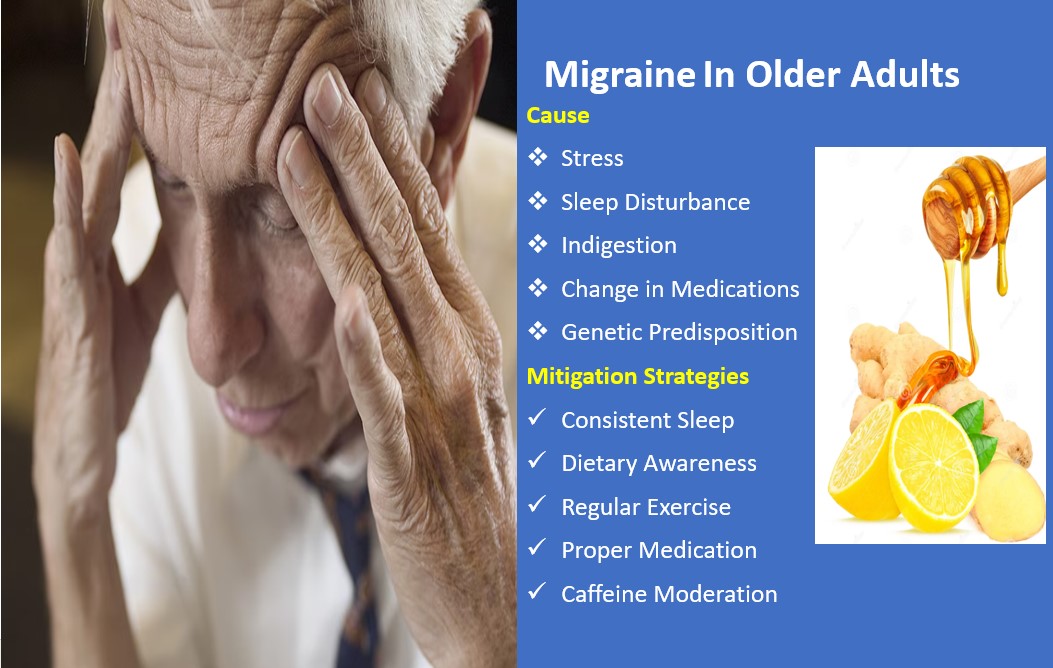Migraine is a common and debilitating condition that affects millions of adults worldwide. Unlike ordinary headaches, migraines are often accompanied by intense pain, sensitivity to light and sound, nausea, and visual disturbances. Understanding the causes of migraines in adults and exploring effective mitigation strategies is essential for reducing their frequency and impact on daily life.
Causes of Migraines in Adults
Migraines can be triggered by a variety of factors, which can differ from person to person. Common causes include:
Stress: Emotional and physical stress is one of the most frequent triggers of migraines in adults. Work pressure, family responsibilities, or major life changes can all contribute to the onset of migraines.
Hormonal Changes: Fluctuations in hormone levels, especially estrogen, are a significant trigger for migraines in women. This is often seen during menstruation, pregnancy, or menopause.
Sleep Disturbances: Irregular sleep patterns, insufficient sleep, or even excessive sleep can trigger migraines. Adults who experience sleep apnea or chronic insomnia are particularly at risk.
Diet and Hydration: Certain foods and drinks can trigger migraines. Common dietary triggers include alcohol (particularly red wine), aged cheese, processed meats, artificial sweeteners, and foods containing MSG (monosodium glutamate). Dehydration is another major factor, as insufficient fluid intake can lead to the onset of migraine symptoms.
Caffeine Consumption: Both excessive caffeine intake and sudden withdrawal from caffeine can cause migraines. Many adults rely on caffeine for alertness, but overconsumption can lead to a rebound effect, triggering headaches.
Sensory Stimuli: Bright or flashing lights, loud noises, and strong smells can provoke migraines in sensitive individuals. Adults working in environments with constant exposure to these stimuli may be more prone to migraine episodes.
Weather Changes: Changes in barometric pressure, high humidity, or extreme heat can influence the onset of migraines. These weather-related triggers are often hard to control, making them a frustrating factor for migraine sufferers.
Medications: Certain medications, including oral contraceptives, vasodilators, and hormone replacement therapy (HRT), can increase the likelihood of migraines in adults, particularly those who are already prone to headaches.
Genetics: A family history of migraines is a significant risk factor. Adults with a genetic predisposition are more likely to experience migraines, although the severity and frequency can vary widely.
Migraine Mitigation Strategies for Adults
While migraines cannot always be prevented, several strategies can help mitigate their frequency and severity. These strategies focus on lifestyle changes, preventive measures, and medical interventions.
Stress Management: Reducing stress is crucial for minimizing migraines. Adults can benefit from relaxation techniques such as deep breathing exercises, yoga, meditation, or progressive muscle relaxation. Regularly practicing mindfulness can also help in reducing overall stress levels.
Consistent Sleep Schedule: Establishing a regular sleep routine can help prevent migraines. Adults should aim for 7-9 hours of uninterrupted sleep each night and try to maintain consistent bedtimes and wake-up times, even on weekends.
Dietary Adjustments: Identifying and avoiding food triggers is essential for reducing migraines. Adults should keep a food diary to track which items may be causing symptoms and focus on maintaining a balanced, nutritious diet. Staying hydrated by drinking plenty of water throughout the day can also prevent dehydration-induced migraines.
Caffeine Moderation: Limiting caffeine intake can help reduce migraine frequency. Adults who consume large amounts of caffeine should reduce their consumption gradually to avoid withdrawal symptoms that can trigger headaches.
Exercise: Regular physical activity, such as walking, swimming, or cycling, can reduce the frequency of migraines. Exercise helps lower stress levels, improves sleep, and releases endorphins, which are natural pain relievers.
Environmental Adjustments: Reducing exposure to sensory stimuli can be an effective mitigation strategy. Adults prone to migraines should wear sunglasses in bright environments, use earplugs in loud settings, and avoid strong perfumes or chemical odors.
Medication: There are both preventive and abortive medications available for migraines. Preventive medications, such as beta-blockers, anticonvulsants, and antidepressants, can be prescribed by a healthcare provider to reduce the frequency of migraines. Abortive medications, like triptans and nonsteroidal anti-inflammatory drugs (NSAIDs), can be taken at the onset of a migraine to alleviate pain and symptoms.
Hormonal Management: For women whose migraines are triggered by hormonal changes, managing hormone levels can be an effective strategy. Hormone replacement therapy or adjusting birth control methods under medical supervision can help stabilize estrogen levels and prevent migraines.
Biofeedback and Cognitive Behavioral Therapy (CBT): These non-pharmacological approaches are gaining recognition as effective migraine mitigation strategies. Biofeedback helps adults become more aware of physiological processes, such as muscle tension or heart rate, enabling them to control their responses to stress. CBT helps change thought patterns and behaviors associated with migraine triggers.
Weather Awareness: While weather cannot be controlled, adults who are aware of their sensitivity to weather changes can take preventive steps. Keeping track of the weather forecast, staying hydrated, and avoiding strenuous activities during extreme weather conditions may help prevent migraines.
Conclusion
Migraines in adults are often triggered by a complex combination of factors, but with proper identification of these triggers and the implementation of mitigation strategies, the frequency and severity of migraines can be significantly reduced. Lifestyle adjustments, stress management, and medical interventions offer a comprehensive approach to managing migraines and improving the quality of life for adults affected by this condition.
(Ginger, Lemon, Honey) – Kashyam Preparation Method – (For one person)
Ingredients
- Ginger, 250 gm
- Lemon, 1 nos
- Honey, 100 gm
Preparation
- Wash the ginger thoroughly, peel the skin cut into small pieces, and grind it as a paste.
- Collect the ginger paste in a vessel and rest for an hour.
- Filter the ginger water.
- Add the lemon juice, and honey to the ginger water.
- Collect the Kashyam in a glass container and place it in the refrigerator.
Any person after 20 years of age should regularly take this kashayam (5 to 10 ml) thrice a week.
Note: As with any supplement or dietary change, it’s important to consult your healthcare provider before incorporating ginger kashayam into your routine, especially if you have underlying health conditions or are taking other medications.



